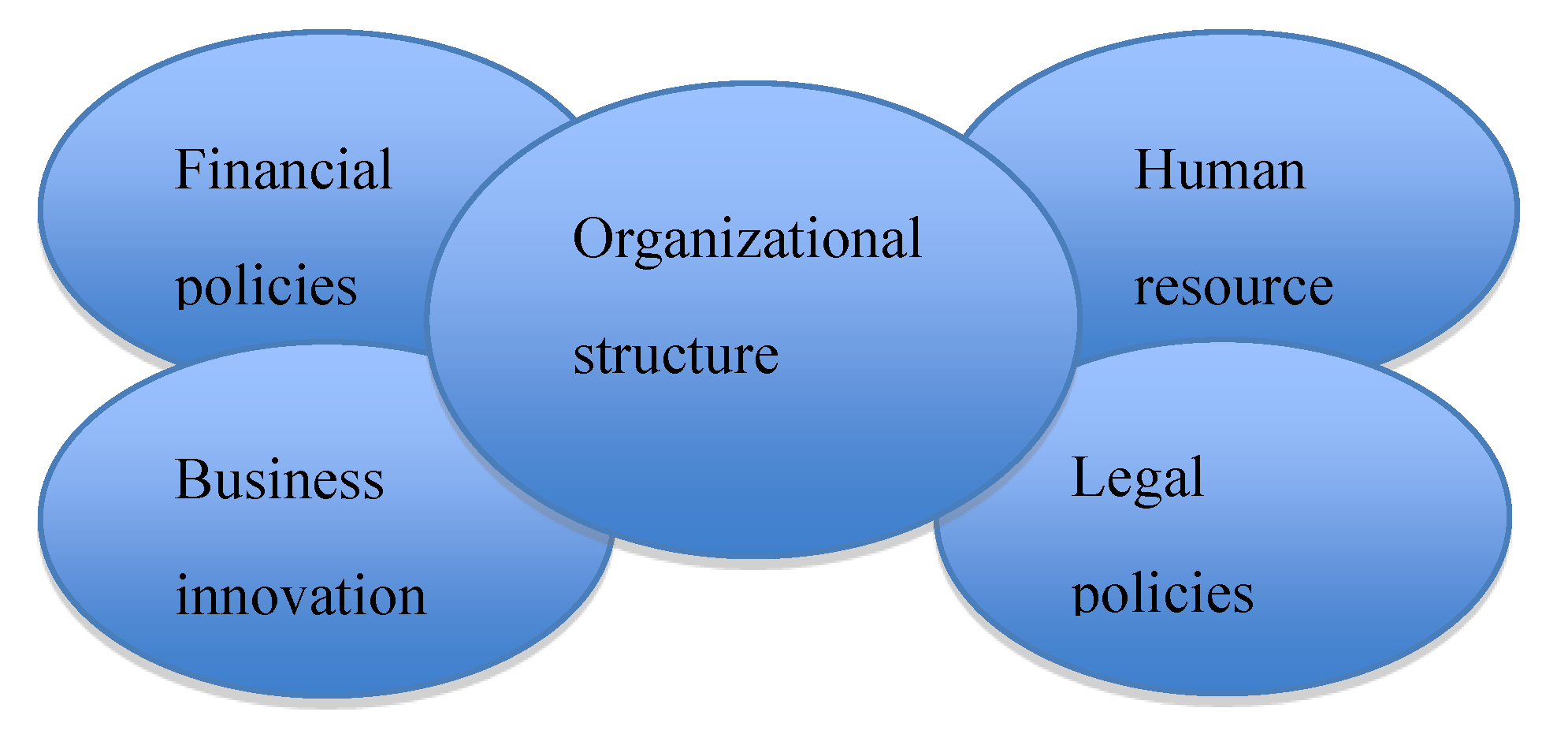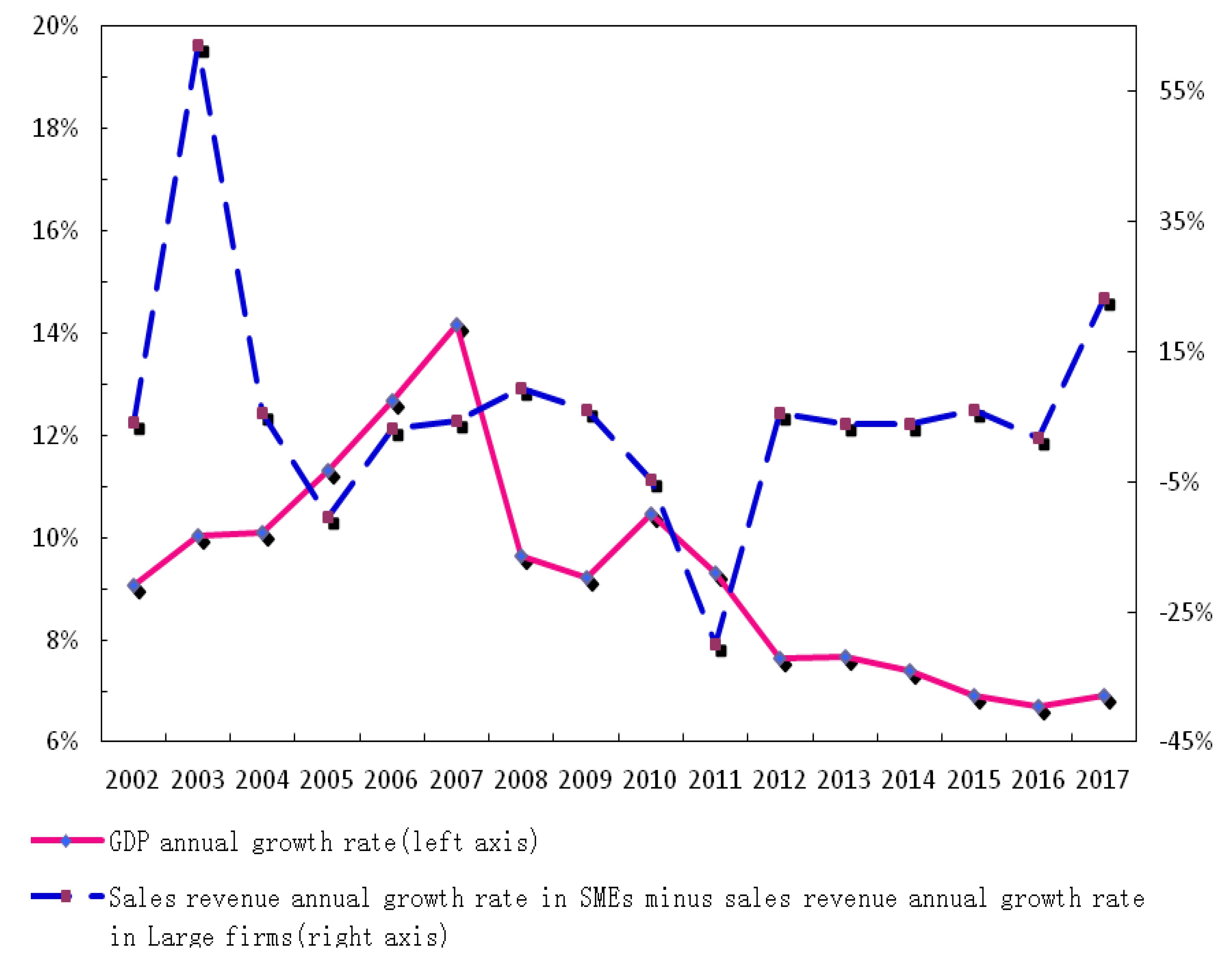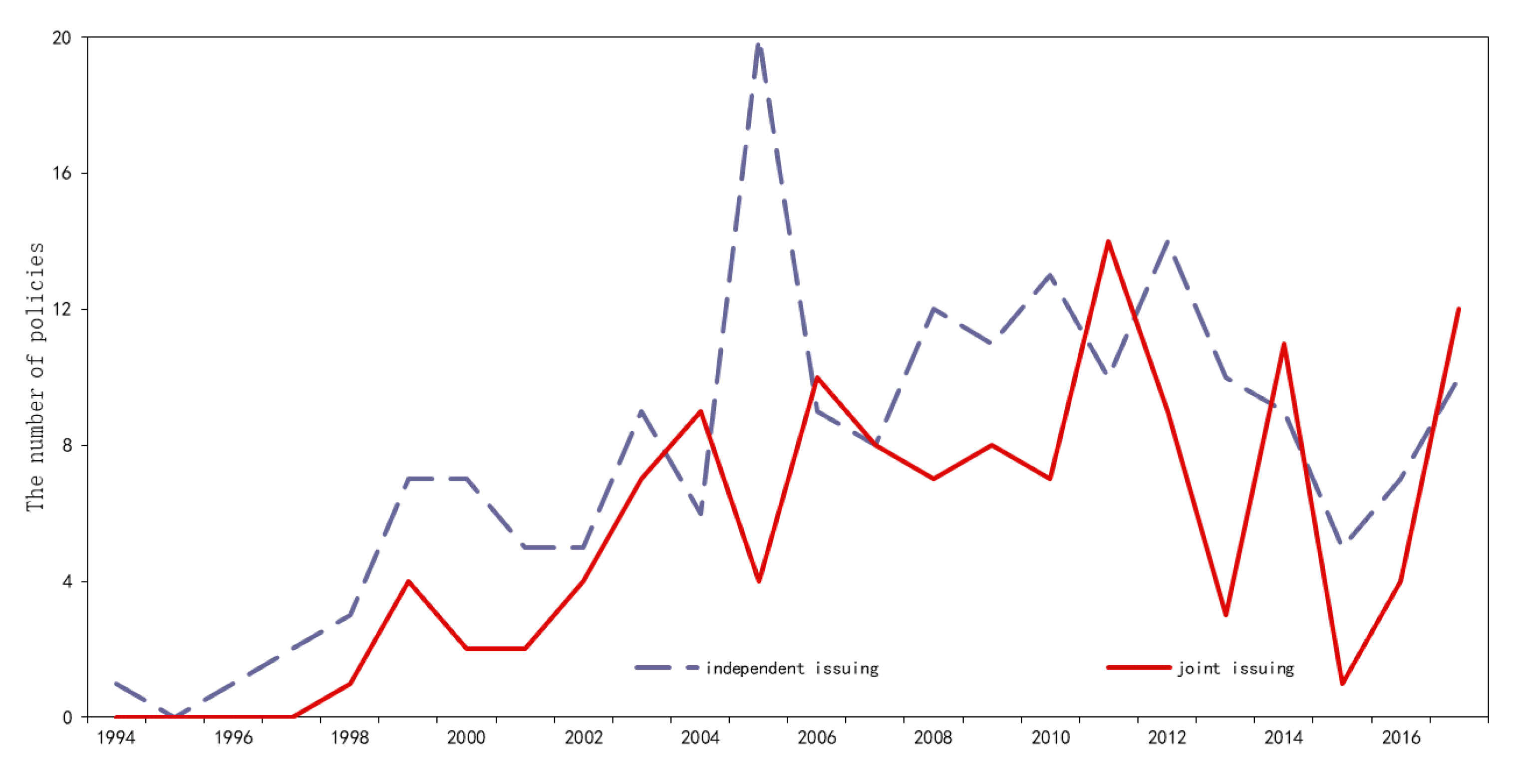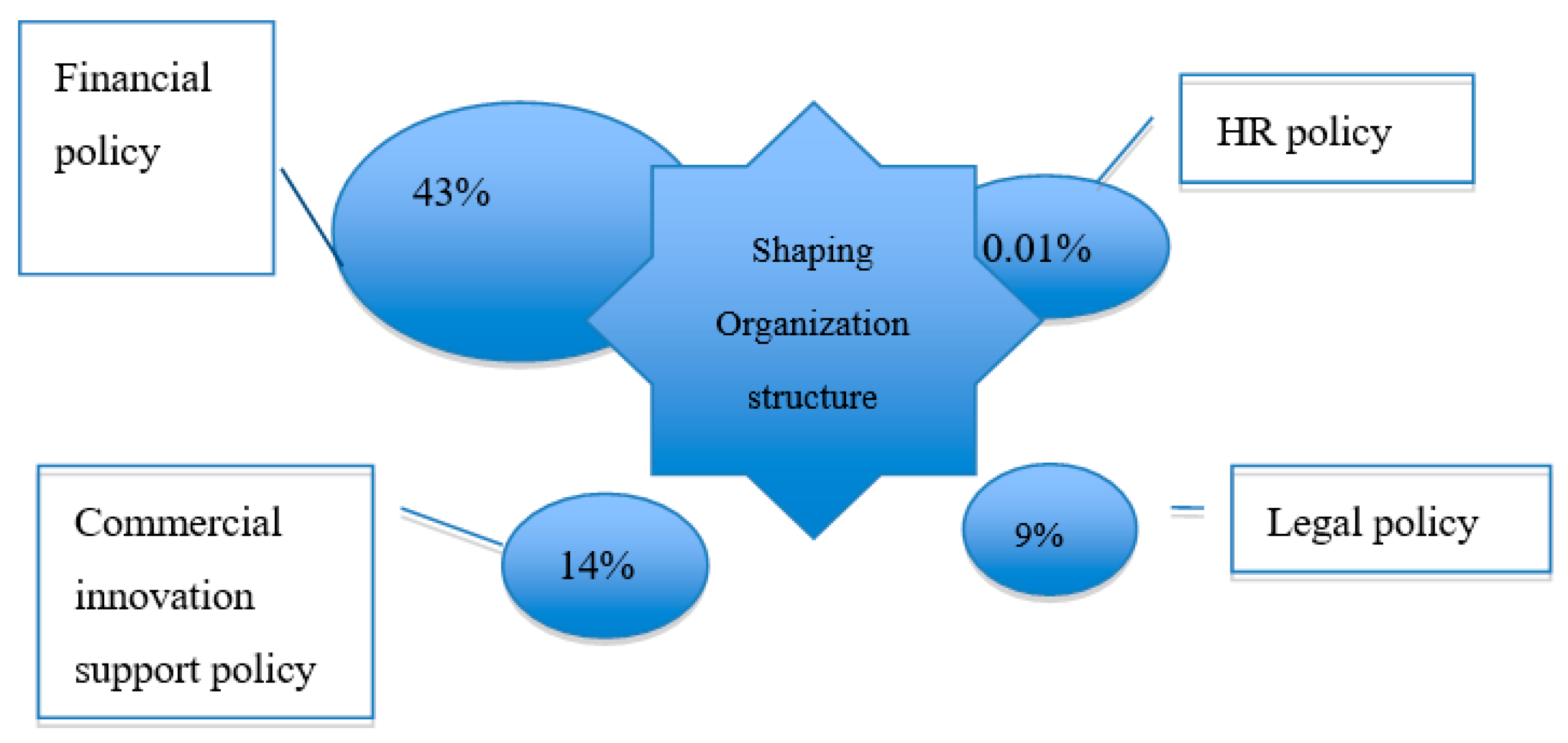Does the Nation Innovation System in China Support the Sustainability of Small and Medium Enterprises (SMEs) Innovation?
Abstract
1. Introduction
2. NIS Innovation Policy and the Economic Contribution of SMEs in China
2.1. Innovation Policy under the NIS Framework
2.2. SME Performance in China’s Macroeconomy
3. Policy Text Sources, Analysis, and Comparison
3.1. Types of Policy Texts
3.2. Issuing Bodies of Policy Documents
3.3. Topics of Policy Texts
4. Some Explanations: Narrow Definition of the NIS and the Evolution of China’s Innovation Policy Objectives
4.1. Narrow Definition vs. General Definition of the NIS
4.2. The Evolution of China’s Technology Policy Objectives
5. Conclusions
Author Contributions
Funding
Acknowledgments
Conflicts of Interest
Abbreviations
| ATP | Advanced Technology Plan |
| DFQFD | Dynamic Function Quality Function Deployment |
| GEM | Growth Enterprise Market |
| FDI | Foreign Direct Investment |
| GDP | Gross Domestic Product |
| HR | Human Resource |
| NIS | National Innovation System |
| OECD | Organization for Economic Co-operation and Development |
| OI | Open Innovation |
| PPI | Producer Price Index |
| QFD | Quality Function Deployment |
| Qt. | Quantity |
| R&D | Research and Development |
| SBA | Small Business Administration |
| SMEs | Small and Medium-sized Enterprises |
| SOEs | State-owned Enterprises |
| STAR Market | Science and Technology Innovation Board |
| TIP | Technology Innovation Project |
| US | the United States |
| VC | Venture Capital |
References
- Schumpeter, J.A. Chapter 7—The Economy as a Whole, English translation of Das Gesamtbild der Volkwirtschaft. In Theorie der wirtschaftlichen Entwicklung; Schumpeter, J.A., Ed.; Blank: Oxford, UK, 2002; Volume 9, pp. 93–145. [Google Scholar]
- Freeman, C. Technology, Policy, and Economic Performance: Lessons from Japan; Pinter Publishers: London, UK; New York, NY, USA, 1987; p. 155. [Google Scholar]
- Khan, A.M.; Manopichetwattana, V. Models for distinguishing innovative and noninnovative small firms. J. Bus. Ventur. 1989, 4, 187–196. [Google Scholar] [CrossRef]
- Lundvall, B.Å. National System of Innovation: Towards a Theory of Innovation and Interactive Learning; Pinter Publishers: London, UK, 1992; p. 317. [Google Scholar]
- Zhang, Y.J. Analysis of SME technology innovation policy from the perspective of policy tools. China Adm. 2012, 4, 43–47. [Google Scholar]
- Charles, E.; Zabala-Iturriagagoitia, J.M. Public Procurement for Innovation as mission-oriented innovation policy. Res. Policy 2012, 41, 1757–1769. [Google Scholar] [CrossRef]
- Saastamoinen, J.; Reijonen, H.; Tammi, T. Should SMEs pursue public procurement to improve innovative performance? Technovation 2018, 69, 2–14. [Google Scholar] [CrossRef]
- Foreman-Peck, J. Effectiveness and efficiency of SME innovation policy. Small Bus. Econ. 2013, 41, 55–70. [Google Scholar] [CrossRef]
- Cho, C.; Park, S.Y.; Son, J.K.; Lee, S. Comparative Analysis of R&D-Based Innovation Capabilities in SMEs to Design Innovation Policy. Sci. Public Policy 2017, 44, 403–416. [Google Scholar] [CrossRef]
- OECD. National Innovation Systems; OECD Publications: Paris, France, 1997. [Google Scholar]
- OECD. Managing National Innovation Systems; OECD Publications: Paris, France, 1999. [Google Scholar]
- Liu, F. Research on the Development Status and Policies of China’s Small and Medium-Sized Enterprises—Research on the Transformation and Upgrade of Small and Medium-Sized Enterprises in the New Situation. Contemp. Econ. Manag. 2014, 36, 9–18. [Google Scholar] [CrossRef]
- Zhang, W.G.; Yan, R. Research on the Changes of China’s SME Innovation Policy Based on the Measurement of Policy Texts. J. Xiangtan Univ. (Philos. Soc. Sci.) 2017, 41, 19–28. [Google Scholar] [CrossRef]
- Zheng, Y.; Wang, H. The government supports the innovation of small and medium-sized enterprises: Theoretical basis, policy characterization and function path. Mod. Econ. Res. 2017, 10, 126–132. [Google Scholar] [CrossRef]
- Cao, W.C.; Shan, M.Y.; Li, G. Research on the evaluation system of sustainable innovation capability of small and medium-sized science and technology enterprises based on DFQFD model. Technol. Econ. 2013, 26, 36–40. [Google Scholar]
- Li, J.; Yang, B.B.; Pan, Z. Ownership concentration of SMEs, product market competition and sustainability of enterprise innovation. China Sci. Technol. Forum 2016, 5, 59–64. [Google Scholar] [CrossRef]
- Burlea-Schiopoiu, A.; Mihai, L.S. An Integrated Framework on the Sustainability of SMEs. Sustainability 2019, 11, 6026. [Google Scholar] [CrossRef]
- Hou, J.; Chen, J.; Song, H.; Wang, G. Are Non-R&D Innovation Activities Actually Effective for Innovation Sustainability? Empirical Study from Chinese High-Tech Industry. Sustainability 2019, 11, 174. [Google Scholar] [CrossRef]
- Zhang, Z.G.; Chen, Z.M.; Li, Y.J. Research on the relationship between open innovation, absorptive capacity and innovation performance. Sci. Res. Manag. 2015, 36, 49–56. [Google Scholar] [CrossRef]
- Cui, H.Y.; Shi, J.J. Research on the relationship between open innovation, government support and the performance of leading agricultural enterprises. Agric. Econ. Issues 2013, 34, 84–91. [Google Scholar] [CrossRef]
- Zheng, D.L.; Zhong, S.H. 30 Years of Chinese High-Tech Policy: Based on the Analysis on Policy Text. Sci. Technol. Prog. Countermeas. 2010, 27, 90–93. [Google Scholar]
- Liu, Y.; Ye, X.T.; Yang, F.J.; Tan, L.; Liu, W.L. Concept, classification and evolution characteristics of China’s national innovation system internationalization policy—A quantitative analysis based on policy text. Manag. World 2014, 12, 62–69, 78. [Google Scholar] [CrossRef]
- Duncan, L.E.; Kern, F.; Rogge, K.S. The co-evolution of policy mixes and socio-technical systems: Towards a conceptual framework of policy mix feedback in sustainability transitions. Res. Policy 2019, 48, 103555. [Google Scholar] [CrossRef]
- Ossenbrink, J.; Finnsson, S.; Bening, C.R.; Hoffmann, V.H. Delineating policy mixes: Contrasting top-down and bottom-up approaches to the case of energy-storage policy in California. Res. Policy 2019, 48, 103582. [Google Scholar] [CrossRef]
- Magro, E.; Wilson, J.R. Policy-mix evaluation: Governance challenges from new place-based innovation policies. Res. Policy 2019, 48, 103612. [Google Scholar] [CrossRef]
- Mavrot, C.; Hadorn, S.; Sager, F. Mapping the mix: Linking instruments, settings and target groups in the study of policy mixes. Res. Policy 2019, 48, 103614. [Google Scholar] [CrossRef]
- Edquist, C.; Hommen, L. Systems of innovation: Theory and policy for the demand side. Technol. Soc. 1999, 21, 63–79. [Google Scholar] [CrossRef]
- Liu, X.L.; White, S. Comparing innovation systems: A framework and application to China’s transitional context. Res. Policy 2001, 30, 1091–1114. [Google Scholar] [CrossRef]
- Zeng, D.M.; Wang, Y.J.; Qin, L.L. Research on the interaction between national innovation system and innovation policy system from the perspective of knowledge flow. J. Hunan Univ. (Soc. Sci. Ed.) 2009, 23, 39–43. [Google Scholar]
- Lundvall, B.Å. Innovation policy in the globalizing learning economy. In The Globalizing Learning Economy; Archibugi, D., Lundvall, B.Å., Eds.; Oxford University Press: Oxford, UK, 2002; pp. 273–291. [Google Scholar]
- Huang, C.; Celeste, A.; Mark, S.; Borges, G.; Augusto, M. Organization, Programme and Structure: An analysis of the Chinese Innovation Policy Framework. R D Manag. 2004, 34, 367–387. [Google Scholar] [CrossRef]
- Ministry of Science and Technology of the People’s Republic of China. China Science and Technology Statistics Data Book; Ministry of Science and Technology: Beijing, China, 1994–2017.
- Department of Social Science, Technology and Cultural Industry Statistics of National Bureau of Statistics; Department of Innovation and Development of Ministry of Science and Technology. China Science and Technology Yearbook; China Statistical Press: Beijing, China, 1994–2017.
- China Government Legal Information Network. Available online: http://www.moj.gov.cn/news/content/2019-01/03/446_225903.html (accessed on 3 January 2019).
- National Bureau of Statistics. Available online: http://www.stats.gov.cn/tjsj/tjbz/201801/t20180103_1569357.html (accessed on 3 January 2018).
- Zhu, Y.; Wang, Z.; Qiu, S.; Zhu, L. Effects of Environmental Regulations on Technological Innovation Efficiency in China’s Industrial Enterprises: A Spatial Analysis. Sustainability 2019, 11, 2186. [Google Scholar] [CrossRef]
- Lin, M. Study on China’s Technology Innovation Policy for Small and Medium-sized Enterprises. People’s Forum Sci. Front. 2019, 10, 104–107. [Google Scholar] [CrossRef]
- Lundvall, B.Å.; Jensen, M.B.; Johnson, B.; Lorenz, E. Forms of knowledge and modes of innovation. Res. Policy 2007, 36, 680–693. [Google Scholar] [CrossRef]
- Freeman, C. The borderless world: Management lessons in the new logic of the global market place: Kenichi Ohmae. Res. Policy 1992, 21, 553–554. [Google Scholar] [CrossRef]
- Ergas, H. Why Do Some Countries Innovate More Than Others? Centre for European Policy Studies: Brussels, Belgium, 1984. [Google Scholar]
- Ergas, H. Does Technology Policy Matter? In Companies and Nations in the World Economy; Guile, B., Brooks, H., Eds.; National Academy Press: Washington, DC, USA, 1987; pp. 191–280. [Google Scholar]
- Lee, K.H. Lee Kun-Hee’s Big Stick; The Korea Times: Seoul, Korea, 2006. [Google Scholar]




| Policy Composition | Content | Description |
|---|---|---|
| Organizational structure | Policymaking and executive institution | |
| Financial policies | a. Current science and technology projects (1) | (1) Including the National Natural Science Fund, the 973 Program, the National Science and Technology Support Plan, the 863 Program, the Science and Technology Condition Platform, policy guidance for science and technology projects and other special projects (the Spark Program, the Torch Program, the National New Key Product Plan, the National Soft Science Research Plan), other (the key international technology cooperation plan, SME innovation fund) |
| b. Tax policy and Foreign Direct Investment (FDI) policy | ||
| c. Venture Capital (VC) and stock market | ||
| Business innovation support system | a. Science parks, experimental areas and incubation centers | |
| b. China’s high-tech fair | ||
| c. Productivity promotion centers | ||
| Human resource policies | a. Developing a basic education plan | (2) Including rewards and funded projects for teachers, student awards and student projects, international cooperation and exchange |
| b. Project 211 on higher education | ||
| c. Human resource projects of the Ministry of Education (2) | ||
| Legal policies | a. Intellectual property law and competition law | |
| b. Science and technology law and education law |
| Type | Law | Regulation | Provision | Opinion | Method | Decision | Assessment Indicator |
|---|---|---|---|---|---|---|---|
| Quantity (Qt.) | 5 | 2 | 1 | 45 | 9 | 2 | 1 |
| Type | Rules | Notices | Reply description | Declaration | Guidance | Development plan | Total |
| Quantity (Qt.) | 3 | 216 | 2 | 2 | 5 | 1 | 294 |
| Type | Joint Publication | National People’s Congress | The General Office of the State Council | Departments of the State Council |
|---|---|---|---|---|
| Qt. | 117 | 5 | 24 | 106 |
| Departments directly under the State Council | Business units directly under the State Council | National bureaus managed by the ministries and commissions of the State Council | Institute specifically created directly under the State Council | Other |
| 25 | 9 | 1 | 1 | 6 |
| Joint Publication Bodies | Between the Institutes of the State Council | Within the Institutes of the State Council | Between the Institutes of the State Council and Other Departments | ||||||||||||
|---|---|---|---|---|---|---|---|---|---|---|---|---|---|---|---|
| Number of bodies | 2 | 3 | 4 | 5 | 6 | 7 | 8 | 10 | 12 | 2 | 3 | 4 | 10 | 2 | 6 |
| Number of texts | 35 | 8 | 4 | 3 | 2 | 1 | 1 | 2 | 1 | 45 | 3 | 3 | 1 | 6 | 2 |
| Total | 57 | 52 | 8 | ||||||||||||
| Topic | Financial Policies | Supervision | Industry Innovation and Development | Social Services (Information) | Employment |
|---|---|---|---|---|---|
| Number | 125 | 42 | 37 | 31 | 25 |
| Percentage | 43% | 14% | 13% | 11% | 8% |
| Comprehensive policy | Law | Business innovation structure | Legal enforcement | Human resource training | Total |
| 16 | 5 | 5 | 4 | 4 | 294 |
| 5% | 2% | 2% | 1% | 1% | 100% |
| Topic | Loan Guarantee and Credit Guarantee | Tax | Financial Development | Financial Services | Technology and Innovation Funds |
|---|---|---|---|---|---|
| Number | 44 | 21 | 17 | 14 | 8 |
| Percentage | 35% | 17% | 14% | 11% | 6% |
| Topic | International market | Finance and investment | Venture capital | Listing | Total |
| Number | 7 | 6 | 6 | 2 | 125 |
| Percentage | 6% | 5% | 5% | 1% | 100% |
© 2020 by the authors. Licensee MDPI, Basel, Switzerland. This article is an open access article distributed under the terms and conditions of the Creative Commons Attribution (CC BY) license (http://creativecommons.org/licenses/by/4.0/).
Share and Cite
Jia, C.; Tang, X.; Kan, Z. Does the Nation Innovation System in China Support the Sustainability of Small and Medium Enterprises (SMEs) Innovation? Sustainability 2020, 12, 2562. https://doi.org/10.3390/su12062562
Jia C, Tang X, Kan Z. Does the Nation Innovation System in China Support the Sustainability of Small and Medium Enterprises (SMEs) Innovation? Sustainability. 2020; 12(6):2562. https://doi.org/10.3390/su12062562
Chicago/Turabian StyleJia, Caiyan, Xiaoyun Tang, and Zhehan Kan. 2020. "Does the Nation Innovation System in China Support the Sustainability of Small and Medium Enterprises (SMEs) Innovation?" Sustainability 12, no. 6: 2562. https://doi.org/10.3390/su12062562
APA StyleJia, C., Tang, X., & Kan, Z. (2020). Does the Nation Innovation System in China Support the Sustainability of Small and Medium Enterprises (SMEs) Innovation? Sustainability, 12(6), 2562. https://doi.org/10.3390/su12062562




